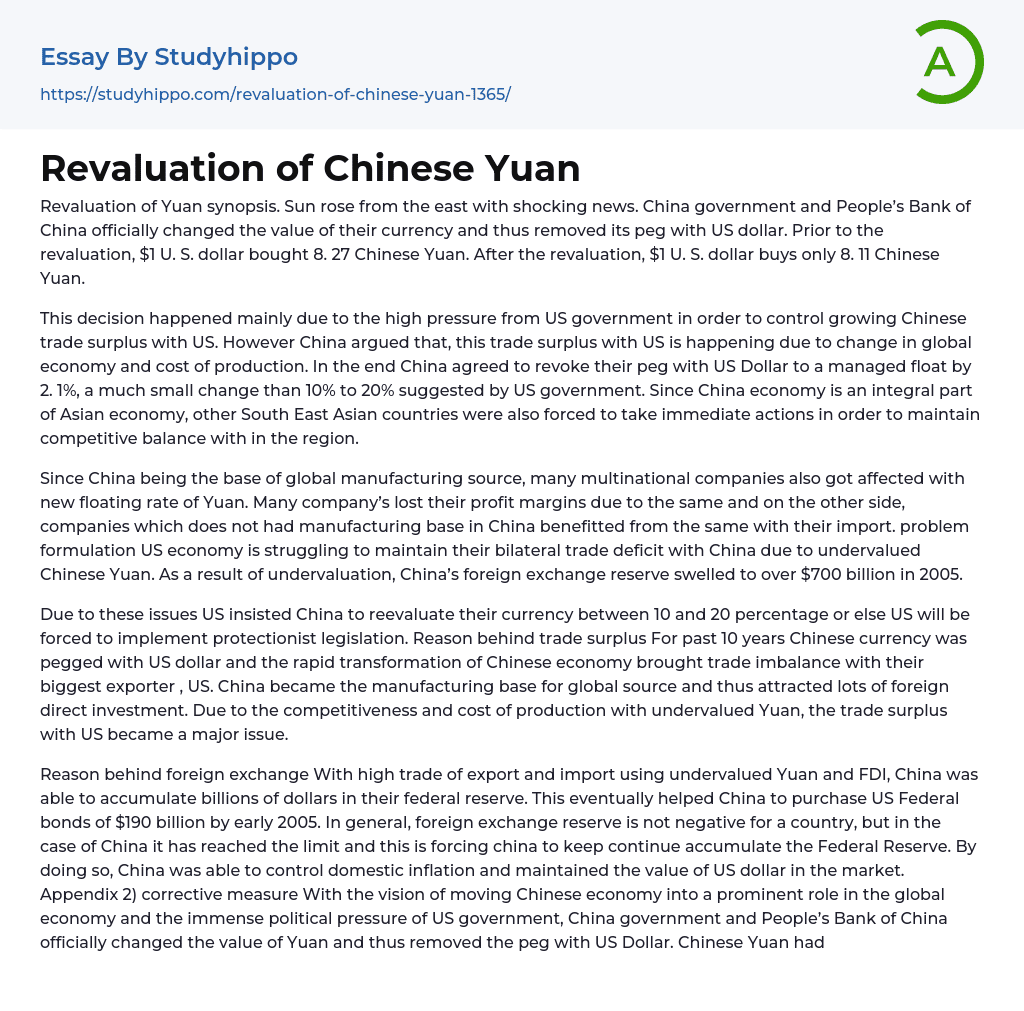Revaluation of Yuan synopsis. Sun rose from the east with shocking news. China government and People’s Bank of China officially changed the value of their currency and thus removed its peg with US dollar. Prior to the revaluation, $1 U. S. dollar bought 8. 27 Chinese Yuan. After the revaluation, $1 U. S. dollar buys only 8. 11 Chinese Yuan.
This decision happened mainly due to the high pressure from US government in order to control growing Chinese trade surplus with US. However China argued that, this trade surplus with US is happening due to change in global economy and cost of production. In the end China agreed to revoke their peg with US Dollar to a managed float by 2. 1%, a much small change than 10% to 20% suggested by US government. Since China economy is an integral part of Asian economy, other South East
...Asian countries were also forced to take immediate actions in order to maintain competitive balance with in the region.
Since China being the base of global manufacturing source, many multinational companies also got affected with new floating rate of Yuan. Many company’s lost their profit margins due to the same and on the other side, companies which does not had manufacturing base in China benefitted from the same with their import. problem formulation US economy is struggling to maintain their bilateral trade deficit with China due to undervalued Chinese Yuan. As a result of undervaluation, China’s foreign exchange reserve swelled to over $700 billion in 2005.
Due to these issues US insisted China to reevaluate their currency between 10 and 20 percentage or else US will be forced to implement protectionis
legislation. Reason behind trade surplus For past 10 years Chinese currency was pegged with US dollar and the rapid transformation of Chinese economy brought trade imbalance with their biggest exporter , US. China became the manufacturing base for global source and thus attracted lots of foreign direct investment. Due to the competitiveness and cost of production with undervalued Yuan, the trade surplus with US became a major issue.
Reason behind foreign exchange With high trade of export and import using undervalued Yuan and FDI, China was able to accumulate billions of dollars in their federal reserve. This eventually helped China to purchase US Federal bonds of $190 billion by early 2005. In general, foreign exchange reserve is not negative for a country, but in the case of China it has reached the limit and this is forcing china to keep continue accumulate the Federal Reserve. By doing so, China was able to control domestic inflation and maintained the value of US dollar in the market. Appendix 2) corrective measure With the vision of moving Chinese economy into a prominent role in the global economy and the immense political pressure of US government, China government and People’s Bank of China officially changed the value of Yuan and thus removed the peg with US Dollar. Chinese Yuan had been pegged with US dollar since 1997 and this has sustained through the Asian Financial Crisis of 1997/98 and it also provided stable currency base for the rapid development of Chinese economy. The immediate measure taken by government to reevaluate the currency by 2. % can induce a rise in US interest rate which lowers US demand and also encourage
other Asian countries to allow their currency to appreciate against US dollar. This led to a lower export from China to US and thus retains the trade imbalance deficit between US and China. By removing the peg with dollar, china transitioned their currency to a floating exchange rate and joins the US Dollar, the euro and yen in the forefront of the global financial system. Due to the competitive implication China decided to reevaluate their currency from 8. 28Y/$ to 8. 11Y/$ and allowed the value to fluctuate 0. % per day over the previous day’s closing price. By doing so China was able to protect the investors and companies alike against large sudden changes and also prevented government intervention to rebalance this imbalance in the globalization scheme. For example Chinese multinationals like the Haier Group suffer only a 2% increase in cost versus foreign market pricing immediately. The Yuan’s new freedom to float 0. 3% helped them with a growing operational risk from exchange rates over time.
Applying the formula (8. 28 + 20%) = 9. 036 This means, the trade deficit of US with China will rise, China will be forced to keep on buying the US government bonds to control inflation. Meantime the export of china will rise and helps to the growth of economy in terms of foreign direct investment, Balance of Payments and Balance of Trade.
- African American essays
- African American Culture essays
- American Values essays
- Asian American essays
- Chinese essays
- Ethnicity essays
- Ethnocentrism essays
- German essays
- Han Chinese essays
- Hispanic essays
- Identity essays
- Korean essays
- Mexican essays
- Nation essays
- Native American essays
- Race and Ethnicity essays
- White People essays
- Bank essays
- Banking essays
- Corporate Finance essays
- Credit Card essays
- Currency essays
- Debt essays
- Donation essays
- Enron Scandal essays
- Equity essays
- Financial Accounting essays
- Financial Crisis essays
- Financial News essays
- Financial Ratios essays
- Financial Services essays
- Forecasting essays
- Foreign Exchange Market essays
- Free Market essays
- Gold essays
- Investment essays
- Legacy essays
- Loan essays
- Market Segmentation essays
- Money essays
- Personal finance essays
- Purchasing essays
- Retirement essays
- Shareholder essays
- Stock Market essays
- Supply And Demand essays
- Venture Capital essays
- American Dream essays
- Barriers To Entry essays
- Capitalism essays




